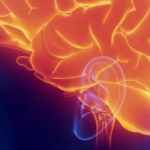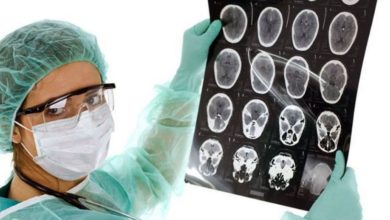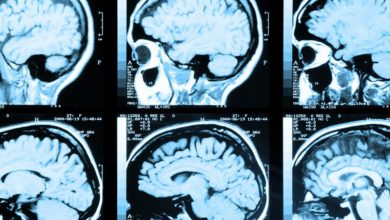Skull cancer
The content of the article
In medicine there are oncological diseases, otherwise they are called malignant formations; skull cancer also refers to such ailments. Oncology of the cranial bone is a malignant formation in parts of the skull, as well as in the facial and brain regions.
What it is?
This disease can affect people of any age. The medulla consists of the vault and base of the skull.
The primary formation of cranial bones and soft tissues of the head with a benign pathological process has the ability to grow, which will begin to destroy them. They are located near the corner of the eye in the form of dermoid cysts.
There are soft tissues on the head, on which defects begin to appear, forming on the bone plate on the outside. Meningiomas begin to grow into the bones, this occurs along the length of the osteon canals. Tissue compaction and destruction occurs, in some cases this is associated with the proliferation of osteoblasts.
Types of malignant processes of the cranial bone
Cancer of the cranial bone is represented by:
- Malignant fibrous histiocytoma;
- Ewing's sarcoma in the tissues of the skull;
- Chordoma at the cranial base;
- Osteogenic sarcoma in the temporal part;
- Chondrosarcoma with parts of cartilaginous tissue mutation.
Chondrosarcoma is a malignant pathological process of the skull bone, which grows from cartilage tissue. It harms the larynx, skull and trachea. This disease is rare in children; most often it affects people whose age ranges from twenty to seventy-five years. It appears as a bony protrusion that is covered with cartilage. Also, chondrosarcoma can be the result of malignancy of a pathological benign process.
Osteosarcoma
A tumor of the base of the skull is often not primary and is created from bone cells. It affects the forehead, temple and back of the head. Such formations reach large sizes; they intend to rapidly develop and disintegrate into the dura mater.
With a tumor of the base of the skull, the symptoms are as follows: during cancer of the cranial bone, metastases begin to occur very quickly, such a formation grows very rapidly. During the x-ray, the lesion will be noticeable: it will have an uneven outline and the presence of borderline osteosclerosis. In this case, children are more often at risk due to mutation of bone tissue during growth, and people in the age category from ten to thirty years can also suffer from this disease. In old age, the probability of the disease is ten percent. Treatment must be started immediately, for which special drugs for the tumor are used, for example, Cisplatin or Vincriston, and ionizing radiation is also used.
Ewing's sarcoma
Sarcoma begins to grow, this happens in bone and soft tissues, which is a consequence of malignant neoplasms in other areas. The tumor contains large round cells, but their nuclei are small. They may contain hemorrhages and necrosis. Ewing's sarcoma of the head greatly affects human development; this begins to manifest itself from the very first months.
People with this diagnosis have complaints such as:
- Heat;
- Increased leukocytes;
- Secondary anemia begins to progress.
Children and adolescents are most susceptible to this disease. It can be irradiated and treated with medications. It is possible for the sick person to live up to nine years if radiotherapy is carried out in a timely manner.
Fibrous histiocytoma and fibrosarcoma
The malignant pathological process of the skull bone begins to arise in tissues such as muscle and fat, as well as in tendons and ligaments.
After which it begins to affect the bones, especially the jawbone, cancer cells begin to spread to vital organs and lymph nodes. The population most affected by this disease is middle-aged to elderly. Plasma and tumor cells begin to form near the calvarium
It originates in the flat cranial bones and in the bones of the facial region.
Chordoma
If chordoma is present, it most often leads to death. This disease mainly affects the male population after the age of thirty.
The pathological process of the base of the skull is divided into two types:
- general infectious;
- cerebral.
General infectious diseases include:
- Feeling weak;
- Sharp weight loss;
- The complexion becomes white;
- Increase in temperature;
- Chills or increased sweating;
- Sensations intermittent with fever, when the body temperature is above forty and a sharp drop to normal limits;
- Increasing the number of white blood cells in the blood.
General cerebral include:
- Headache with high intracranial pressure, which is accompanied by nausea and vomiting; the fundus of the eye also begins to change;
- Seizures of epilepsy, they begin to manifest themselves with intracranial hypertension;
- The heartbeat periodically begins to change to forty or fifty beats per minute;
- Mental disorders;
- A person begins to think more slowly;
- Lethargy, drowsiness, and sometimes a state of coma.
Osteogenic sarcoma of the skull bone is interpreted by a subcutaneous compaction that is motionless and is also characterized by pain if the skin over it is squeezed. Enlargement of the lymph nodes of the head and neck often occurs. With metastases, hypercalcemia begins to develop, which is accompanied by nausea and vomiting, excessive urination, dry mouth and impaired consciousness.
Please rate the article:





